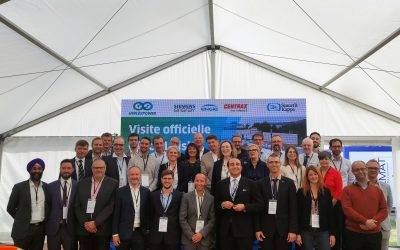TherVacB Project Begins Hepatitis B Patient Trial
TherVacB Project Begins Patient Trial to Advance Curative Strategy for Chronic Hepatitis B.
Press release – Munich, 22 July 2025
Chronic hepatitis B virus (HBV) infection remains a significant global health concern, affecting an estimated 254 million people worldwide and contributing to over one million deaths each year through liver failure and liver cancer. While current antiviral therapies can suppress viral replication, they do not eliminate the virus and often require lifelong treatment. There is an urgent need for accessible curative strategies that can relieve the long-term medical and economic burden.
The TherVacB project, a European research initiative coordinated by Helmholtz Munich, has now reached a major milestone with the launch of its clinical trial in patients. Building on over a decade of research, the project aims to deliver a novel, affordable, and curative immunotherapeutic approach to chronic hepatitis B. This integrated approach spans basic research, preclinical and clinical development, and is supported by tools such as a European HBV Patient Registry and inclusive outreach strategies—informed by ethical guidance on the use of social media-based recruitment—to help reach individuals not yet engaged in regular medical care. A dedicated clinical site in Tanzania contributes to building local capacity for HBV diagnosis and treatment, while multilingual communication ensures that project updates and educational content are accessible to communities across the globe.
TherVacB’s milestone in patient recruitment follows a successful phase 1a trial in healthy volunteers, in which the TherVacB vaccine candidate demonstrated a favourable safety profile and triggered the desired immune responses. The TherVacB EU project consortium now advances to a multi-centre phase 1b/2a trial, evaluating the safety, tolerability, and immune efficacy of the vaccine in patients with chronic HBV infection who are receiving standard antiviral therapy.
“This transition into patient trials is a major milestone,” said Prof. Dr. Ulrike Protzer, Project Coordinator of TherVacB and Director of the Institute of Virology at Helmholtz Munich and the Technical University of Munich. “TherVacB represents more than just a vaccine – it’s an immune therapy aiming to empower the immune system to control or even eliminate the virus. This approach, when combined with prophylactic vaccination, screening, and awareness, supports the global goal of eliminating hepatitis B as a public health threat.”
A Precision-Engineered Immunotherapeutic Approach
At the core of the TherVacB approach is a heterologous prime-boost vaccination regimen that uses specifically assembled protein antigens for priming followed by a viral vector (MVA) boost, designed to induce both antibody production and strong virus-specific T-cell responses. This approach is intended to be effective against more than 95% of global HBV strains and aims to address the different epidemiological patterns of hepatitis B found across continents.
Trial Design and Patient Impact
The clinical trial, which began in June 2025, is sponsored by LMU University Hospital Munich. It is enrolling a total of 81 patients across multiple international clinical sites in Germany, Italy, Spain, the United Kingdom, and Tanzania. The study is designed in two sequential phases:
- Phase 1b: Patients receive ascending doses of the vaccine components to establish the safest and most effective regimen.
- Phase 2a: The optimal dose selected from Phase 1b will be tested in a larger group of patients to confirm safety and evaluate the antiviral effect in chronically infected patients.
This clinical study represents a pivotal step toward achieving a functional cure – characterized by the sustained absence of detectable HBV and liver inflammation without the need for ongoing antiviral treatment. Further details about the study are available via the trial registration on ClinicalTrials.gov (NCT06513286).
Looking Ahead
The clinical trial marks a cornerstone in the broader scope of the EU-funded TherVacB project, which is committed to advancing a curative treatment for chronic hepatitis B. The project aligns with global elimination efforts, including the United Nations Sustainable Development Goal (SDG) 3.3 to combat viral hepatitis by 2030.
If successful, TherVacB could become the first therapeutic vaccine to offer a functional cure – an outcome current antiviral therapies do not achieve. This shall significantly reduce the burden of disease, prevent progression to cirrhosis and liver cancer, and lower hepatitis B-related mortality worldwide. The results of this trial will inform future phases of clinical development. They may also help shape global treatment strategies, particularly in low- and middle-income countries, where access to lifelong antiviral medication remains limited.
By providing a cost-effective, scalable, and immune-based approach, TherVacB has the potential to reach populations most affected by hepatitis B. Combined with existing preventive vaccination, screening programmes, and awareness campaigns, it could be a game-changer in the fight against viral hepatitis.
About the TherVacB EU Project
TherVacB is a European research project supported by the EU Horizon 2020 programme under grant agreement No. 848223. Coordinated by Helmholtz Munich, the project runs from January 2020 to December 2026 and brings together leading expertise in virology, immunology, and clinical vaccine development. It also includes ethical research on social media-based patient recruitment, addressing regulatory and societal considerations through a dedicated study. This international collaboration reflects a shared commitment to developing and delivering an affordable, curative immunotherapeutic strategy for chronic hepatitis B.
The TherVacB consortium consists of 17 partners from five European countries and Tanzania, including academic institutions, university hospitals, public health research centres, SMEs, and consultancies. In addition to clinical and translational research, TherVacB supports patient identification through the European HBV Patient Registry. A clinical site in Tanzania strengthens local capacity for diagnosis and treatment. Multilingual outreach ensures broad access to project information.
PNO Innovation Germany (formerly ARTTIC Innovation GmbH) proudly supports the TherVacB project by leading its communication, dissemination, and stakeholder engagement activities. We are honoured to contribute to this important international research initiative as project partner (https://www.thervacb.eu/team/pno-innovation/).
![]()
- Helmholtz Munich, Deutsches Forschungszentrum für Gesundheit und Umwelt GmbH
- LMU University Hospital Munich with the Institute of Infectious Diseases and Tropical Medicine and the Liver Center Munich
- Technical University of Munich (TUM) and TUM University Hospital Rechts der Isar (TUM-MRI) with four departments (Institute of Molecular
- Immunologie und Experimentelle Onkologie, Klinik für Innere Medizin II Hepatologie/Gastroenterologie, Institut für Virologie, IHEM – Institut für Geschichte und Ethik in der Medizin)
- University Medical Center Hamburg-Eppendorf (UKE), I. Medical Department for Gastroenterology
- Helmholtz Centre for Infection Research (HZI)
- University Hospital Leipzig, Department of Hepatology
- Technical University of Munich (TUM)
- Frankfurt University Hospital, Centre of Internal Medicine – Gastroenterology, Endocrinology, and Pneumology (ZIM1)
- SocraTec R&D GmbH
- PNO Innovation GmbH (formerly ARTTIC Innovation GmbH)
![]()
- University College London, IIT – Institute of Immunity & Transplantation
- Barts and the London NHS Trust, Royal London Hospital
- Royal Free London NHS Foundation Trust, Liver Unit
![]()
- Fundació Clínic per a la Recerca Biomèdic (FCRB), Hospital Clínic de Barcelona (HCB) and August Pi i Sunyer Biomedical Research Institute (IDIBAPS)
![]()
- Azienda Ospedaliero-Universitaria of Parma, Unit of Infectious Diseases and Hepatology in Parma
![]()
- National Institute for Medical Research (NIMR Tanzania), Mbeya Medical Research Center (MMRC)
For more information:
- The TherVacB project website in several languages: www.thervacb.euTherVacB EU-Projektwebseite in mehreren Sprachen: https://www.thervacb.eu/
- TherVacB clinical trial details: clinicaltrials. gov – NCT06513286
- Follow the project’s journey on TherVacB social media: X @TherVacB_EU | BlueSky thervacb-eu.bsky.social | YouTube https://www.youtube.com/@TherVacB
- Latest news in the TherVacB media center: https://www.thervacb.eu/media-center/
- TherVacB Press Contact: Tanja Oster, TherVacB Project Office, thervacb_management@eurtd.com
Participation as an opportunity and a challenge
Participation as an opportunity and a challenge Why a new position paper is important for co-creation in EU-funded research projectsWhy a New Position Paper Matters for Co-Creation in EU-funded Research ProjectsA recently published position paper, Partizipation als...
Junior Funding Consultant (m/f/d)
We offer you the unique opportunity to become part of a successful & young team in the attractive growth market for tax-incentivised research funding (R&D tax credits). We are looking for Junior Funding Consultants with a passion for innovation, scientific...
R&D tax credits (Forschungszulage) or ZIM? A choice without agony
R&D tax credits (Forschungszulage) or ZIM? - A choice without agony -R&D tax credits vs. ZIM: The initial scenarioIn practice, small and medium-sized enterprises (SMEs) ask themselves which national funding programme they should pursue for their research and...
POWERBASE facilitates green transition of emergency response organisations
POWERBASE project improves working conditions and facilitates the green transition of emergency response organisations.Twelve emergency response and research organisations have joined forces to prepare future procurement of renewable energy technologies to set the...
Why the carousel of amendments to the R&D tax credit law continues to turn
The R&D tax credits in 2024The year 2024 has proven to be decisive for the German R&D tax credits. Following the most recent amendment as part of the Growth Opportunities Act in March, the Federal Government realized during the budget consultations for 2025...
Register Now: In Conversation with EBiSC2
Unlocking the Potential of Stem Cells: Discover the EBiSC Journey to SustainabilityJoin the conversation on the initiative that’s shaping the future of biomedical research! On May 15, 2024, from 14:15 to 15:00 CEST (Europe/Brussels time), the Innovative Health...
The R&D tax credit with a blind eye to earnings –
Why loss-making companies (wrongly) hesitate
Recapitulation The German R&D tax credit has become much more popular in recent years after a modest response following the introduction of the instrument. This can be seen not only in advertising and studies by various associations, but also in the bare figures...
First successful demonstration with 100% green H2
HYFLEXPOWER celebrates successful operation of a gas turbine with 100% green H2On October 12, 2023, at a public event hosted at the HYFLEXPOWER demonstrator site in Saillat-sur-Vienne, France, the HYFLEXPOWER consortium unveiled a ground-breaking achievement - the...
New Security Project AGILE Will Improve Disaster Risk Management
New international security project to improve disaster risk management for unexpected eventsThe international security project AGILE will kick start today. The project is to develop novel tools and methodologies for understanding, anticipating, and managing High...
How the government’s draft of the Growth Opportunities Act refines the research allowance
Government draft of the Growth Opportunities ActThe government draft of the submitted Growth Opportunities Act has once again undergone a significant redesign compared to the draft bill (§ 33 from p. 71). The revision regarding the Research Grants Act rewards small...









